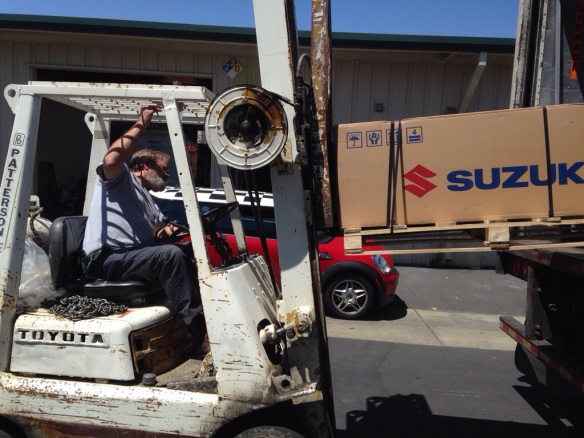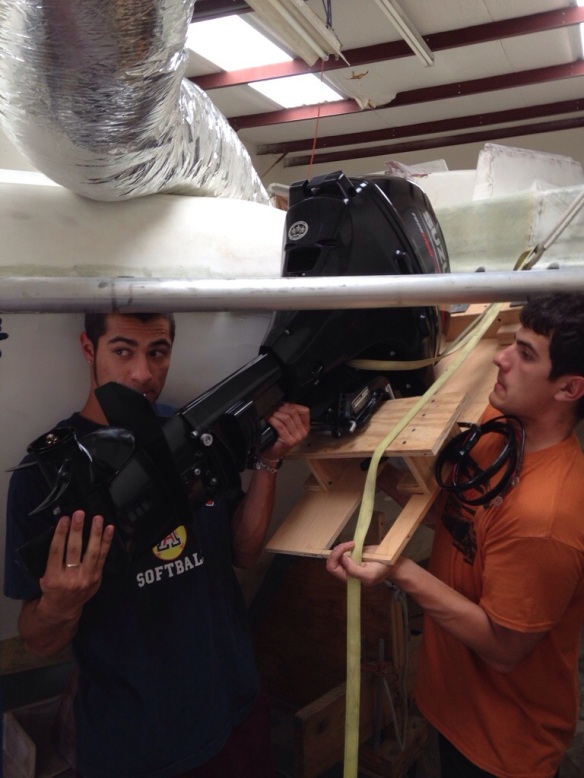Holy cow, it’s hard prepping the boat for ocean voyaging while also finishing building the thing! We’re extremely motivated by the thought that the tools will only grow farther away with every coming sailing day this fall. So now is the moment to finish those little bits!
Counter space is small and the stove is used only minutes a day. So here’s a new rough carbon crap catcher. 

Need more cubbies for the little stuff. This encloses the back part of the chart table. 
The engine ran perfectly two weeks ago during the long motorsail back from Drakes Bay. ChrisH, RickH and I set out last Friday for the Farallones (and whales) but the motor started misfiring before we left the bay. We sailed back to a Richmond and had a live exercise of building up the stored dinghy, side tying and using the 10hp motor tug boat. That worked well. Chris, after I replaced that fuel filter, the symptoms returned and haunted a Sunday sail with our siblings. So Labor Day became Suzuki Day. 

 I think it was actually the three year old spark plugs, as my solo test drive Tues morn was smooth. Pulling the lower unit to change water pump impeller worked really well with engine lowered into the dinghy.
I think it was actually the three year old spark plugs, as my solo test drive Tues morn was smooth. Pulling the lower unit to change water pump impeller worked really well with engine lowered into the dinghy.
While buying parts I asked the Suzuki dealer about propellers and our inability to power above 4300 rpm. And we have very little reverse capability with the stock 9″ diameter, 10 pitch. Two years ago I went rogue and tried a flatter four blade but that didn’t solve it. Wish I had found these Suzuki guys in Sausalito sooner. Came away Wednesday with this. 
 10″, 4 blade, 5″ pitch. Very different and hopefully a game changer. But of course, it didn’t fit right. Here’s the old prop, ready to get the washer and prop nut.
10″, 4 blade, 5″ pitch. Very different and hopefully a game changer. But of course, it didn’t fit right. Here’s the old prop, ready to get the washer and prop nut.  And the new one in same position. Note the brass splines not fully covered up by the prop hub. That’s bad.
And the new one in same position. Note the brass splines not fully covered up by the prop hub. That’s bad.  So an overnight package to get the ONE proper spacer available from Suzuki USA today, and hopefully tomorrow we’ll be motoring again.
So an overnight package to get the ONE proper spacer available from Suzuki USA today, and hopefully tomorrow we’ll be motoring again.
Old knees make getting aboard a little tricky. This booster now helps. 

 Charlie, that’s a recut of the aft cabin companionway ladder you and i designed over a Subway sandwich in Santa Rosa five years ago. Time flies.
Charlie, that’s a recut of the aft cabin companionway ladder you and i designed over a Subway sandwich in Santa Rosa five years ago. Time flies.
And for Kai, no more worrying about our dinghy tags. Finally figured out to bond flexible plastic to the hull with pvc patch glue. And a trip to AAA with $15 to get replacement stickers.  Yes I know they’re not the required 3″ away from the boat’s number. Live dangerously.
Yes I know they’re not the required 3″ away from the boat’s number. Live dangerously.
Still lots to do in two more days before Sunday’s departure. Think good thoughts for motor and spinnaker testing tomorrow. We may be sailors but would really appreciate a calm day tomorrow. Good luck with that around here :)
Three weeks ago the boat participated in an organized Crew Overboard Recovery drill. Great exercise and big thanks to Chris, Dan and Anton. In retrospect, we didn’t stop the boat soon enough. I had chosen to drop the sails, which we did quickly but a lot of distance gets by quickly in a breeze. Round up and stall is my new mantra for this. Meanwhile, our quick-deploy 4:1 hoist got Anton on deck really well. The gear and crew worked great. Truls did a nice write up here. https://www.latitude38.com/lectronic/2019/09/04/#crew-overboard-but-not-by-accident
































































